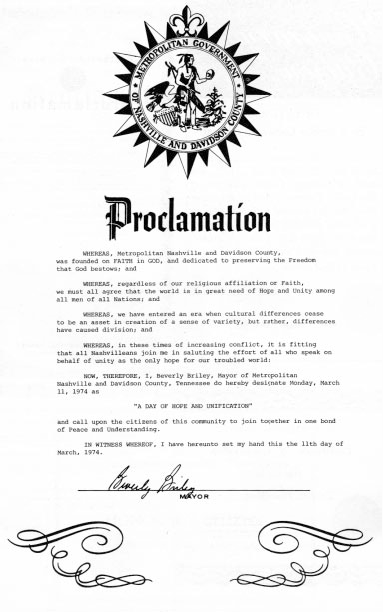
40 Years in America

|
|
40 Years in America |
|
A National Movement Emerges

Hundreds of proclamations and keys to cities were presented to Rev. Moon during the Day of Hope era.
By July 1, 1973, midway through its three-year period (1972-74) of "total mobilization," the Unification Church was emerging as a national movement. It had attained organizational solidarity through the One World Crusade, which as of July 1973, had mobile units in all fifty states, and its versatility had been demonstrated through initiatives in evangelization, finances, the sciences, and interaction with public officials. Still, the Unification Church was largely invisible to the public. The seven-city tour attracted only marginal notice in the press. Mobile Fundraising Teams, although growing, attracted virtually no notice. The Science Conference was reviewed only in isolated scientific journals, and Rev. Moonís meetings with Congressmen were private.
However, during the second eighteen months of this revival period, the Unification Church attracted national coverage and began to have a national impact. Several internal developments contributed to this. The first was the reshuffling of local leadership. Although center members had been called to pioneer missions, the leadership of existing centers had remained intact. However, in December 1972, center directors were assigned as new bus team leaders. This included Farley Jones, President of HSA-UWC who was succeeded by Neil Salonen. The arrival of European and Japanese missionaries during 1973 was especially important. This "new pilgrim movement," as Rev. Moon termed it, transformed the One World Crusade into the International One World Crusade (IOWC). The arrival of Europeans and Japanese greatly enhanced witnessing and further solidified the American movement as a sense of national identity emerged. Rather than as part of Miss Kimís, Mr. Choiís or Mr. Kimís groups, members saw themselves as part of the American movement.
On March 1, 1973, the movement convened its first 100-day International Training Session at Belvedere. The schedule included forty days of intensive study of the Divine Principle, thirty days of the movementís Victory Over Communism (VOC) ideology and thirty days of Unification Thought, a recently published application of the Principle to philosophy. The six hours of daily lectures were interspersed with talks from Rev. Moon, fellowship, discussion, examinations, lecture practice and participation in the ongoing New York City witnessing campaign. Belvedere Training further solidified the American movement. As one of the original forty-eight trainees wrote,
Europeans are not the only ones wearing smiles of eagerness and anticipation. Some American brothers were intoxicated in those early days, because we were so many fine people together and Belvedere is the most holy place in America.
In addition to the training session, Belvedere was the site for national conferences. The first of these was held on March 5, 1973. Headquarters staff, mobile-unit commanders, itinerary workers, state representatives and center directors all gave reports and discussed approaches found to be successful. A second national conference was held on April 1, 1973, at which time it was announced that future national conferences would be held every forty-five days at Belvedere. As a result of these initiatives, the movement not only attained cohesiveness but also began to obtain results. A July, 1973, Directorís Newsletter reported: "the number of new members who joined to date this year is four times that for the same period last year." Financially, the movement had "greatly expanded the limits of what was once thought possible." Another boon to the movementís solidarity and cohesiveness was the July, 1973, distribution of the new English Divine Principle.
The movement reached a turning point by the time of the July 1, 1973 Directorís Conference. With the formation of forty more OWC mobile units at that conference (making fifty total), there was a nation-wide network of support. David Kim summarized Rev. Moonís role in the overall development,
By July 1, 1973, only 18 months after his arrival in the U.S., he had brought phenomenal results. He had completed already one seven-city public speaking tour in major cities on both coasts of the U.S. He had raised the infant Unification Church to nationwide cooperation through the One World Crusade. He had strengthened and enlarged each group to serve all 50 states. Further, he had set up an International Leadership Training Program at the Belvedere Estate. During this same period of time, he initiated and spoke at the First International Conference on Unified Science to begin his efforts to develop a God-centered science and technology, which can truly satisfy every manís desire for material happiness.
Symbolic of the "turning point" the movement had reached halfway through its three-year revival period was the proclamation of July 1, 1973, as the "Day of Resolution for Victory." In effect, the task of attaining internal solidarity was completed. What followed during the second eighteen-month period of evangelism was an all-out campaign by the movement to attain public visibility and to make a national impact.
Download entire page and pages related to it in ZIP format
Table of Contents
Information
Tparents Home